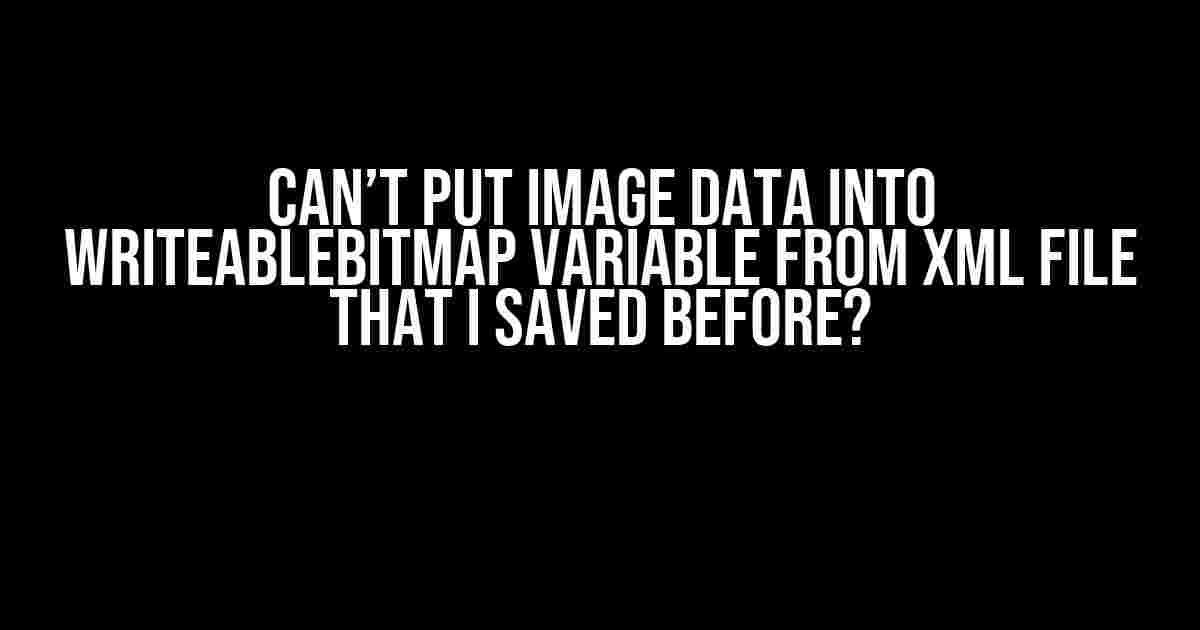If you’re struggling to put image data into a WriteableBitmap variable from an XML file that you saved earlier, don’t worry! You’re not alone. This is a common issue that many developers face, and in this article, we’ll explore the reasons behind it and provide a step-by-step guide to help you overcome this hurdle.
The Problem: Understanding the Issue
Before we dive into the solution, let’s try to understand what’s causing the problem. When you try to put image data into a WriteableBitmap variable from an XML file, you’re essentially trying to deserialize the image data from the XML file and store it in a WriteableBitmap object. However, the XML file only contains the image data as a string, which can’t be directly converted to a WriteableBitmap.
The main reason behind this issue is that the XML file doesn’t contain the actual image data, but rather a Base64-encoded string representation of the image. This encoded string needs to be decoded and converted into a bitmap image before it can be used as a WriteableBitmap.
The Solution: Converting Base64-Encoded String to WriteableBitmap
To overcome this issue, you’ll need to decode the Base64-encoded string and convert it into a bitmap image. Here’s a step-by-step guide to help you do just that:
-
Step 1: Read the XML File
First, you’ll need to read the XML file and extract the Base64-encoded string from it. You can use the following code to achieve this:
string imageData; using (StreamReader reader = new StreamReader("image.xml")) { XDocument doc = XDocument.Load(reader); XElement element = doc.Element("Image"); imageData = element.Value; } -
Step 2: Decode the Base64-Encoded String
Next, you’ll need to decode the Base64-encoded string using the following code:
byte[] imageBytes = Convert.FromBase64String(imageData); -
Step 3: Convert the Byte Array to a BitmapImage
Now, you’ll need to convert the byte array into a bitmap image using the following code:
using (MemoryStream stream = new MemoryStream(imageBytes)) { BitmapImage bitmapImage = new BitmapImage(); bitmapImage.SetSource(stream); } -
Step 4: Convert the BitmapImage to a WriteableBitmap
Finally, you’ll need to convert the bitmap image into a WriteableBitmap using the following code:
WriteableBitmap wb = new WriteableBitmap(bitmapImage);
Putting it all Together
Here’s the complete code that puts it all together:
string imageData;
using (StreamReader reader = new StreamReader("image.xml"))
{
XDocument doc = XDocument.Load(reader);
XElement element = doc.Element("Image");
imageData = element.Value;
}
byte[] imageBytes = Convert.FromBase64String(imageData);
using (MemoryStream stream = new MemoryStream(imageBytes))
{
BitmapImage bitmapImage = new BitmapImage();
bitmapImage.SetSource(stream);
WriteableBitmap wb = new WriteableBitmap(bitmapImage);
// Use the WriteableBitmap variable as needed
}
Troubleshooting Common Issues
While the above code should work for most cases, you might encounter some issues depending on your specific scenario. Here are some common issues and their solutions:
| Issue | Solution |
|---|---|
| Error: “Invalid Base64 string” | Make sure the XML file contains a valid Base64-encoded string. Check for any errors or corruption in the XML file. |
| Error: “Invalid image data” | Check the image data in the XML file to ensure it’s correct and not corrupted. Try re-saving the image data or using a different XML file. |
| Error: “Cannot find the image.xml file” | Make sure the image.xml file is in the correct location and that the file path is correct in the code. Try using an absolute path or checking the file existence before trying to read it. |
Conclusion
In conclusion, putting image data into a WriteableBitmap variable from an XML file that you saved before can be a bit tricky, but it’s definitely achievable with the right approach. By following the steps outlined in this article, you should be able to convert the Base64-encoded string into a WriteableBitmap variable. Remember to troubleshoot common issues and adjust the code according to your specific requirements.
If you’re still struggling to get it working, feel free to ask for help or provide more details about your specific scenario. Happy coding!
Frequently Asked Question
Struggling to load image data into a WriteableBitmap variable from an XML file? You’re not alone! Check out these common questions and answers to help you troubleshoot the issue.
Why can’t I load image data from an XML file into a WriteableBitmap variable?
This is because WriteableBitmap requires image data in a specific format, such as a byte array or a stream, whereas XML files typically store data in a text-based format. You’ll need to convert the XML data into a compatible format before loading it into a WriteableBitmap.
How do I convert XML data into a byte array for WriteableBitmap?
You can use the XmlSerializer class to deserialize the XML data into an object, and then use a BinaryFormatter to convert the object into a byte array. Alternatively, you can use a library like XML-to-Image to simplify the process.
What’s the best way to store image data in an XML file?
Instead of storing image data directly in the XML file, consider storing the image as a separate file and referencing its path or URL in the XML file. This approach makes it easier to load and manipulate the image data in your application.
Can I use a third-party library to simplify image loading from XML files?
Yes, libraries like XamlReader and XmlImage can simplify the process of loading image data from XML files. These libraries provide pre-built functionality for converting XML data into image formats compatible with WriteableBitmap.
How do I troubleshoot issues with loading image data from an XML file?
Start by checking the XML file for errors or inconsistencies in the image data. Verify that the image data is correctly formatted and that the WriteableBitmap is configured correctly. Use debugging tools to step through your code and identify any issues with the deserialization or conversion process.
